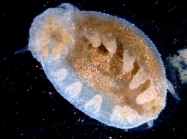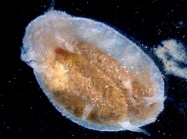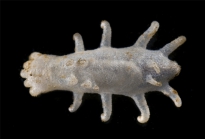| Introduction | | Species lists | | Search taxa | | Taxon tree | | Literature | | Distributions | | Statistics | | Editors | | Match taxa | | Webservice | | Log in |
WoRMS taxon detailsElpidia Théel, 1876
123512 (urn:lsid:marinespecies.org:taxname:123512)
accepted
Genus
Elpidia glacialis Théel, 1876 (type by monotypy)
Tutela Perrier R., 1896 · unaccepted
marine,
Théel, H., 1876. Expedition polaire suedoise. Holothurie nouvelle. Archives de Zoologie Experimental et Générale. 5: 11-14. [details]
Théel, H., 1876. Note sur l'Elpida genre nouveau du groupe des Holothuries. Bihang Kongliga Svenska Vetenskaps-Akademiens Handlingar. 4(4): 7 pps. [details]
Description This genus is well characterized by its rod-shaped spicules with two pairs of obliquely placed horizontal arms and two...
Description This genus is well characterized by its rod-shaped spicules with two pairs of obliquely placed horizontal arms and two vertical apophyses. The genus was formerly regarded as monotypic, but due to the work of mostly Hansen (1956, 1975) and Belyaev (1971, 1975), the genus currently contains 13 nominal and three unnamed species. Some scanty material collected off the south-west coast of southern Africa is here referred to E. gracilis Belyaev, 1975. [details]
WoRMS (2025). Elpidia Théel, 1876. Accessed at: https://www.marinespecies.org/aphia.php?p=taxdetails&id=123512 on 2025-07-16
Nomenclatureoriginal description
Théel, H., 1876. Expedition polaire suedoise. Holothurie nouvelle. Archives de Zoologie Experimental et Générale. 5: 11-14. [details] original description Théel, H., 1876. Note sur l'Elpida genre nouveau du groupe des Holothuries. Bihang Kongliga Svenska Vetenskaps-Akademiens Handlingar. 4(4): 7 pps. [details] original description (of Tutela Perrier R., 1896) Perrier, R. (1896). Sur les Élasipodes recueillis par le <em>Travailleur</em> et le <em>Talisman</em>. <em>Comptes rendus hebdomadaires des séances de l'Académie des sciences.</em> 123(21): 900-903. [details] basis of record Hansson, H.G. (2001). Echinodermata, <B><I>in</I></B>: Costello, M.J. <i>et al.</i> (Ed.) (2001). <i>European register of marine species: a check-list of the marine species in Europe and a bibliography of guides to their identification. Collection Patrimoines Naturels,</i>. 50: pp. 336-351. (look up in IMIS) [details] Othercontext source (PeRMS)
Solís-Marín, F. A.; Alvarado, J. J.; Abreu-Pérez, M.; Aguilera, O.; Alió, J.; Bacallado-Aránega, J. J.; Barraza, E.; Benavides-Serrato, M.; Benítez-Villalobos, F.; Betancourt-Fernández, L.; Borges, M.; Brandt, M.; Brogger, M. I.; Borrero-Pérez, G. H.; Buitrón-Sánchez, E.; Campos, L. S.; Cantera, J.; Clemente, S.; Cohen-Renjifo, M.; Coppard, S.; Costa-Lotufo, L. V.; del Valle-García, R.; Díaz, Y.; Díaz de Vivar, M. E.; Díaz-Martínez, J. P.; Durán-González, A.; Epherra, L.; Escolar, M.; Francisco, V.; Freire, C. A.; García-Arrarás, E.; Gil, D. G.; Guarderas, P.; Hadel, V. F.; Hearn, A.; Hernández, J. C.; Hernández-Delgado, E. A.; Herrera-Moreno, A.; Herrero-Pérezrul, M. D.; Hooker, Y.; Honey-Escandón, M. B. I.; Lodeiros, C.; Luzuriaga, M.; Manso, C. L. C.; Martín, A.; Martinez, M. I.; Martínez, S.; Moro-Abad; Mutschke, E.; Navarro, J. C.; Neira, R.; Noriega, N.; Palleiro-Nayar, J. S.; Pérez, A. F.; Pérez-Ruzafa, A.; Prieto-Rios, E.; Reyes, J.; Rodríguez, R.; Rubilar, T.; Sancho-Mejía, T.; Sangil, C.; Silva, J. R. M. C.; Sonnenholzner, J. I.; Ventura, C. R.; Tablado, A.; Tavares, Y.; Tiago, C. G.; Tuya, F.;Williams, S. M. (2013). Appendix. <em>In: J. J. Alvarado & F. A. Solís-Marín (eds), Echinoderm Research and Diversity in Latin America.</em> pp. 471-510. Springer; Berlin & Heidelberg. page(s): 543-654. [details]
additional source Thandar, A.S. (1999). Deep-sea Holothuroids taken by the R.V. Africana II in 1959, from off the West Coast of the Cape Peninsula, South Africa, Ann. S. Afr. Mus., Vol. 105(9): 364-409, 16 figs, 2 tables (look up in IMIS) [details] additional source The Zoological Record: records of zoological literature relating chiefly to the year. Zoological Society of London City: London, UK. (look up in IMIS) [details] additional source Théel, H. (1877). Mémoire sur l'<i>Elpidia</i>, nouveau genre d'Holothuries. <em>Sv. Ak. Handl.</em> Xiv. 8: 30 pp., 5 pls. [details]  Present Present  Inaccurate Inaccurate  Introduced: alien Introduced: alien  Containing type locality Containing type locality
From editor or global species database
Original description 1876a and b describe same species; unclear which came first. [details]Unreviewed
Description This genus is well characterized by its rod-shaped spicules with two pairs of obliquely placed horizontal arms and two vertical apophyses. The genus was formerly regarded as monotypic, but due to the work of mostly Hansen (1956, 1975) and Belyaev (1971, 1975), the genus currently contains 13 nominal and three unnamed species. Some scanty material collected off the south-west coast of southern Africa is here referred to E. gracilis Belyaev, 1975. [details]
|



